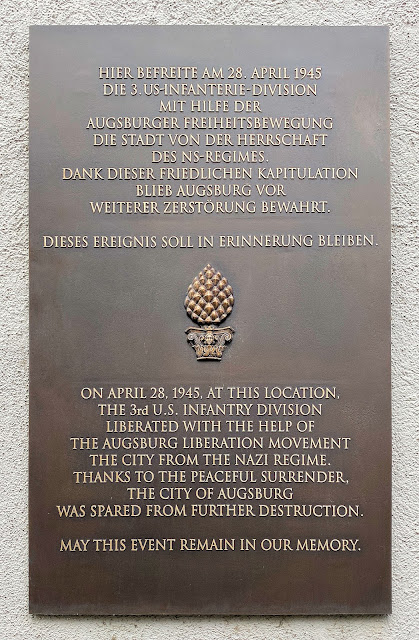On my walk to Augsburg's highlight, the Fuggerei, I passed a commemorative plaque showing a pine cone, Augsburg's coat of arms. It is a tribute to the Romans who took the seeds to their base camp Augusta in Raetia...

|
| US troops entering destroyed Augsburg in 1945 |
... and to the American Forces liberating Augsburg from the Nazi regime on
April 28, 1945.
In passing, I also admired the Alte Metzig (old slaughterhouse) of 1609, proving that butchers have never been poor people.
Barfüßerkirche

|
|
Like Augsburg's cathedral, The Barfüßerkirche is surrounded by profane buildings. |
When Augsburg became protestant, the monastery was dissolved, and the Franciscans left Augsburg in 1526. In 1536 the Barfüßerkirche became Augsburg's first protestant parish church.
You enter the church walking through a densely planted court ...
... obeying the Corona rules.
Inside the building, the walls are covered with oil paintings.
The coronation of the
Winter King, Frederick V of the Palatinate at Prague, painted by an unknown artist, found all my attention for this
provocation of the Habsburgs started the Thirty Years War.
Read more about the history in German.
While I was in the church, a lady entered timidly and asked whether she may take a photo of the Christkind. I had nothing to allow but took a shot too. The Christ Child blessing dating from 1632, was sculptured by Georg Petel.
Berthold Brecht

|
|
Primary-school pupil Berthold Brecht |
I noted a photo and some text on my way out through the cloisters.
Eugen Berthold Friedrich Brecht was baptized on March 20, 1898, at the Barfüßerkirche. On March 29, 1912, he there was confirmed. A childhood friend remembers, "Berthold obviously took confirmation classes quite seriously. He could recite the Bible texts to be learned by heart with ease."
In 1928, a few weeks after the sensation of the Threepenny Opera, which had made Brecht the darling of Berlin's Kurfürstendamm, he was asked about his favorite reading. He answered, "You probably will laugh, the Bible."
The Brechthaus on Auf dem Rain 7 is just around the corner.
So I paid tribute to the 20th-century master of the German language.
Eugen Berthold Friedrich Brecht was baptized on March 20, 1898, at the Barfüßerkirche. On March 29, 1912, he there was confirmed. A childhood friend remembers, "Berthold obviously took confirmation classes quite seriously. He could recite the Bible texts to be learned by heart with ease."
In 1928, a few weeks after the sensation of the Threepenny Opera, which had made Brecht the darling of Berlin's Kurfürstendamm, he was asked about his favorite reading. He answered, "You probably will laugh, the Bible."
When entering the exhibition on my left, yes, he did it again.
Ottmar Hörl's sculpture this time of Berthold. Here are others previously mentioned Richard Wagner,
Johann Wolfgang von Goethe,
Karl Marx,
Martin Luther, and
Ampelmännchen.
*The solutionAfter the uprising of the 17th of JuneThe Secretary of the Writers' UnionHad leaflets distributed on StalinalleeStating that the peopleHad forfeited the confidence of the governmentAnd could only win it backBy increased work quotas. Would it not in that case be simplerfor the governmentTo dissolve the peopleAnd elect another?















No comments:
Post a Comment